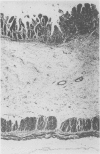Abstract
To describe the pathology and clinical features of segmental necrotising enterocolitis (SNE) in children and adults, 22 diarrhoeal patients (median age two years, range two months to 50 years) in Bangladesh with this lesion detected at autopsy were examined and compared with two groups of diarrhoeal control patients. Gross pathology consisted of purplish or black mucosal or transmural discoloration with erosions or ulcerations in segments of the jejunum or ileum of 18 cases and of the colon alone in four cases. Two patients had intestinal perforations. Microscopically all specimens showed coagulation necrosis or haemorrhagic necrosis indicative of mucosal ischaemia. In 20 cases there was submucosal oedema and nine showed pneumatosis of the bowel. From 11, one or more of the invasive diarrhoeal pathogens Shigella, Campylobacter and Entamoeba histolytica were detected. From the comparison with controls significant associations were found for a long duration of diarrhoea, blood and mucus in stool, abdominal distension or tenderness, shock not attributable to hypovolaemia, septicaemia, and low concentration of serum protein (p less than 0.05). These findings indicated that segmental necrotising enterocolitis develops sometimes as a fatal complication of prolonged diarrhoeal illnesses associated with shock and hypoproteinaemia and is caused by ischaemic injury to the intestinal mucosa.
Full text
PDF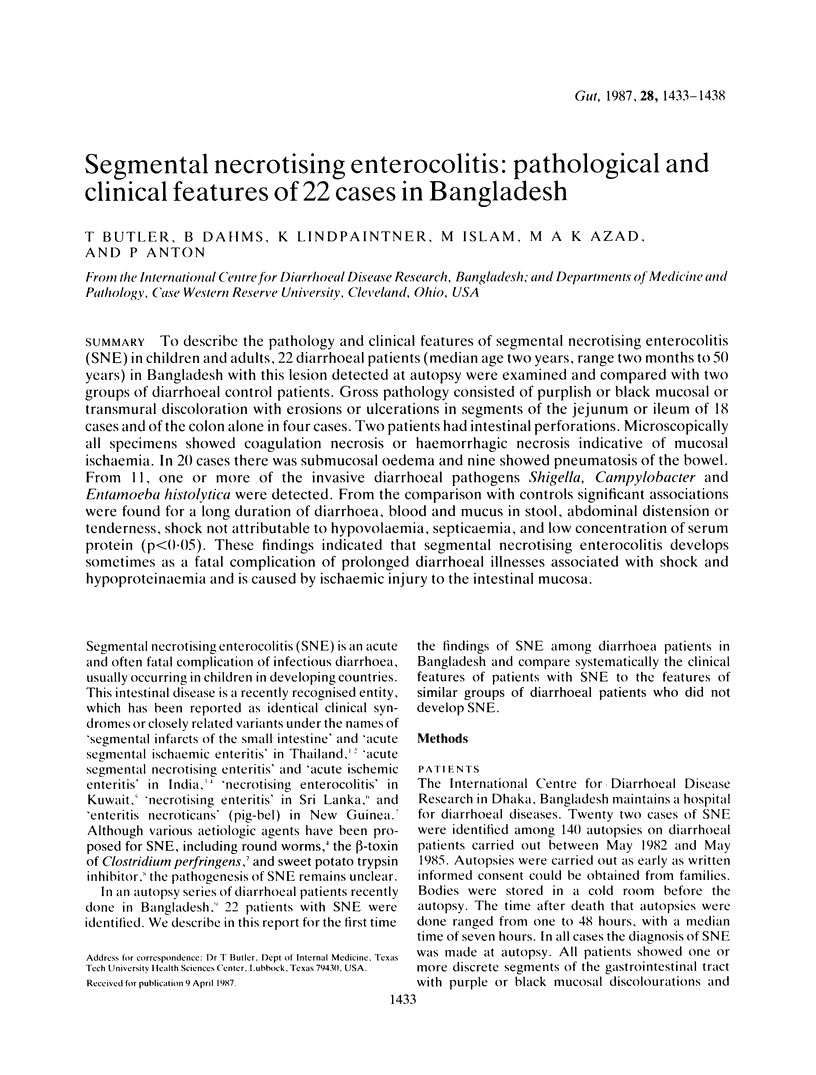
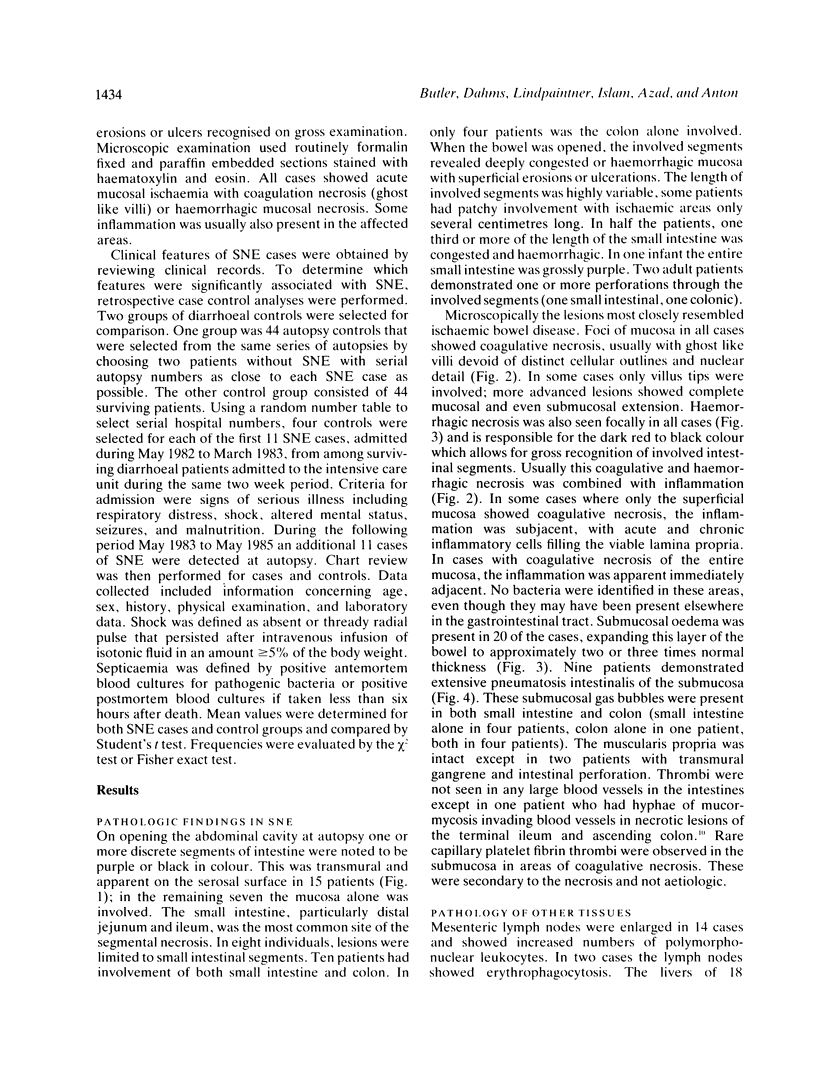

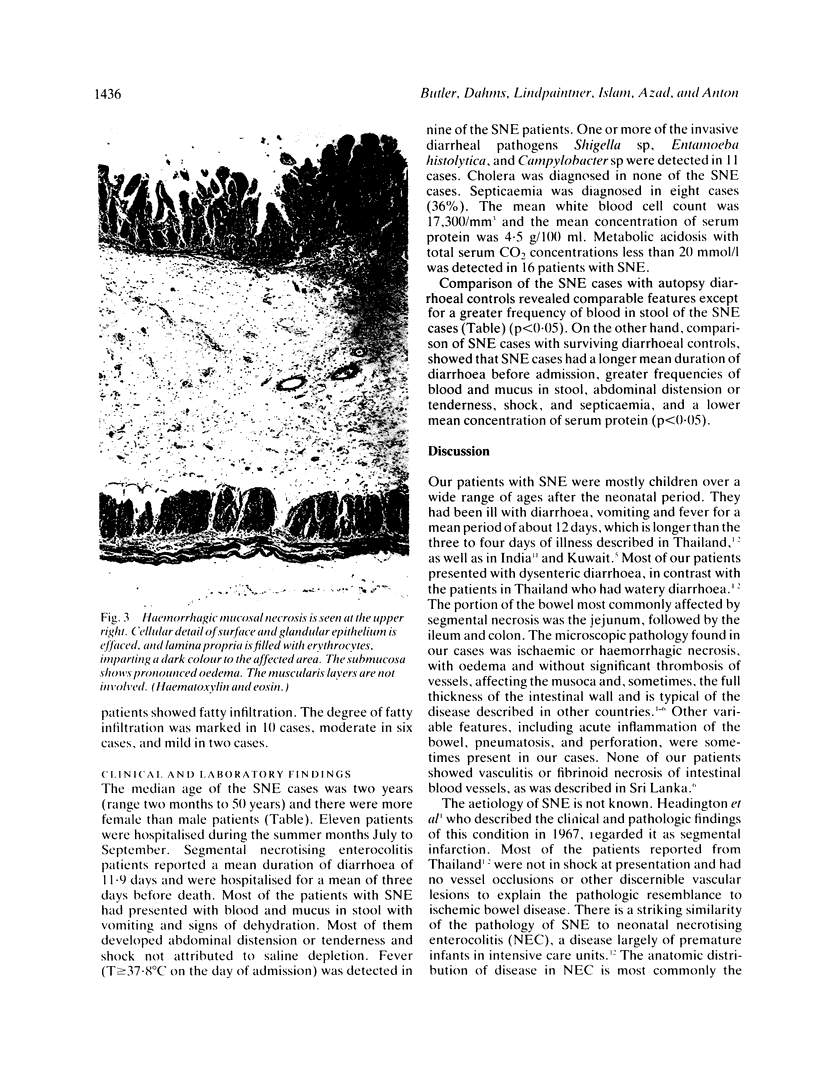
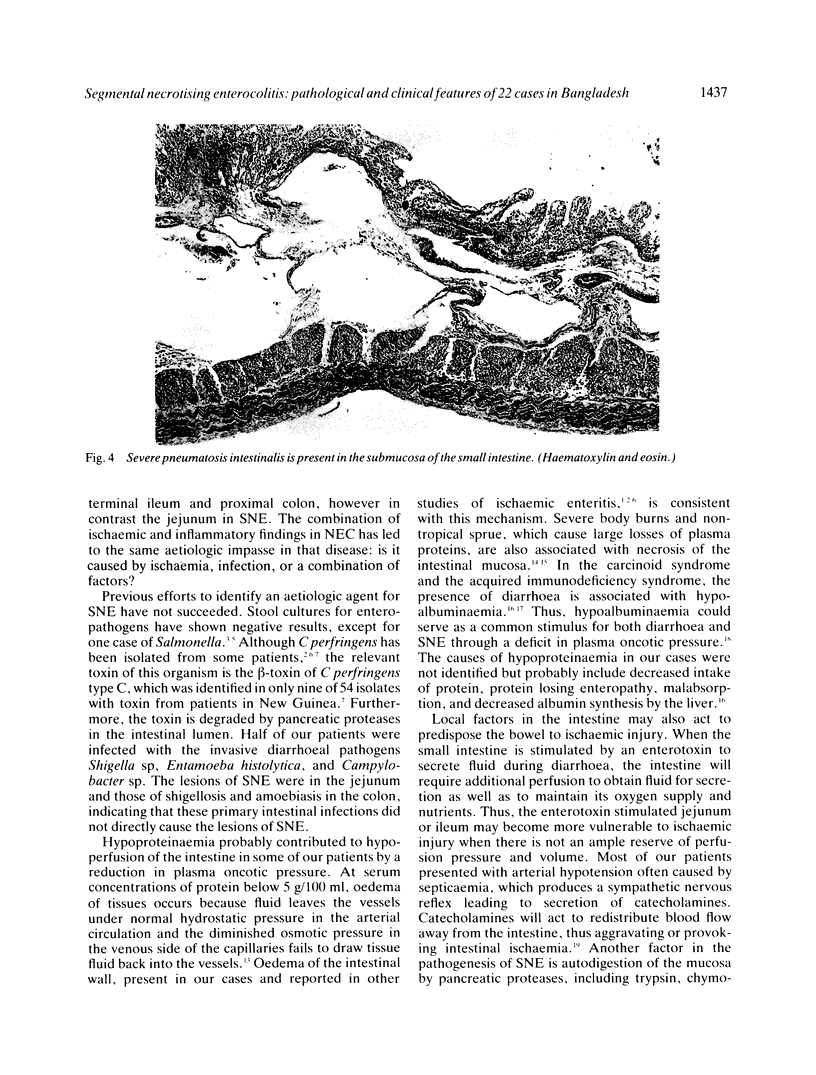
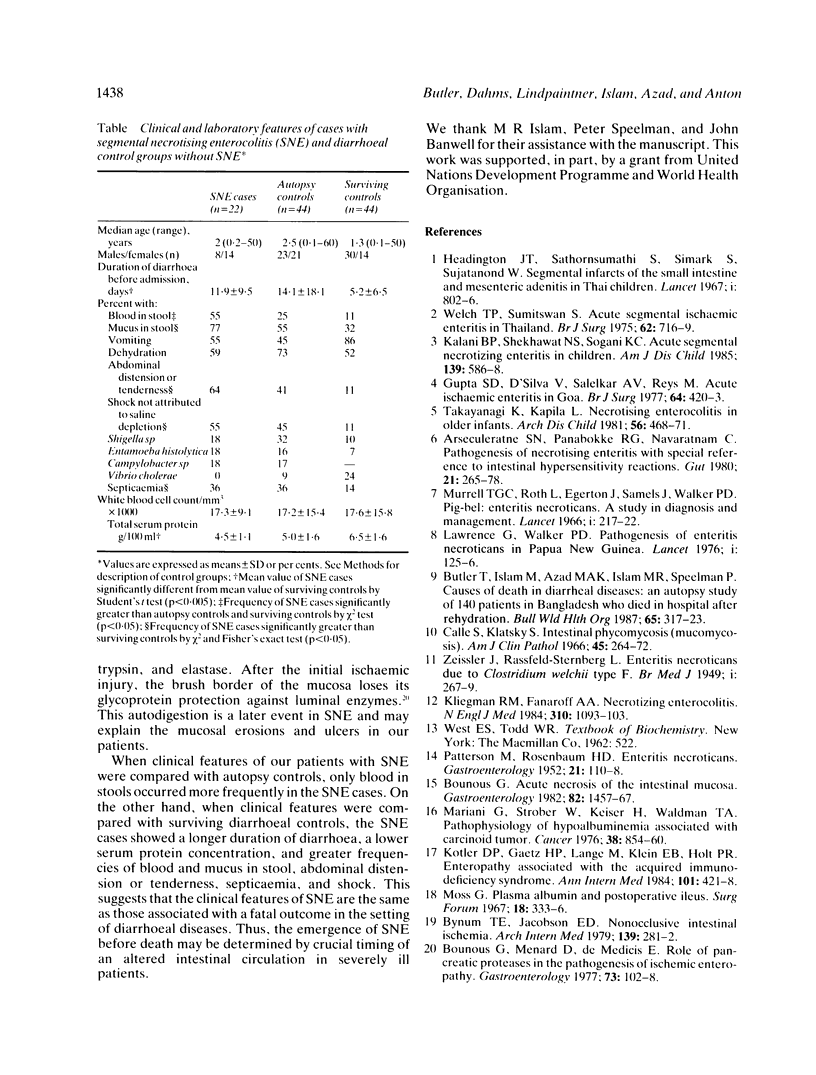
Images in this article
Selected References
These references are in PubMed. This may not be the complete list of references from this article.
- Arseculeratne S. N., Panabokke R. G., Navaratnam C. Pathogenesis of necrotising enteritis with special reference to intestinal hypersensitivity reactions. Gut. 1980 Apr;21(4):265–278. doi: 10.1136/gut.21.4.265. [DOI] [PMC free article] [PubMed] [Google Scholar]
- Bounous G. Acute necrosis of the intestinal mucosa. Gastroenterology. 1982 Jun;82(6):1457–1467. [PubMed] [Google Scholar]
- Bounous G., Menard D., De Medicis E. Role of pancreatic proteases in the pathogenesis of ischemic enteropathy. Gastroenterology. 1977 Jul;73(1):102–108. [PubMed] [Google Scholar]
- Butler T., Islam M., Azad A. K., Islam M. R., Speelman P. Causes of death in diarrhoeal diseases after rehydration therapy: an autopsy study of 140 patients in Bangladesh. Bull World Health Organ. 1987;65(3):317–323. [PMC free article] [PubMed] [Google Scholar]
- Bynum T. E., Jacobson E. D. Nonocclusive intestinal ischemia. Arch Intern Med. 1979 Mar;139(3):281–282. [PubMed] [Google Scholar]
- Calle S., Klatsky S. Intestinal phycomycosis (mucormycosis). Am J Clin Pathol. 1966 Mar;45(3):264–272. doi: 10.1093/ajcp/45.3.264. [DOI] [PubMed] [Google Scholar]
- Gupta S. D., D'Silva V., Salelkar A. V., Reys M. Acute ischaemic enteritis in Goa. Br J Surg. 1977 Jun;64(6):420–423. doi: 10.1002/bjs.1800640613. [DOI] [PubMed] [Google Scholar]
- Headington J. T., Sathornsumathi S., Simark S., Sujatanond W. Segmental infarcts of the small intestine and mesenteric adenitis in Thai children. Lancet. 1967 Apr 15;1(7494):802–806. doi: 10.1016/s0140-6736(67)92773-0. [DOI] [PubMed] [Google Scholar]
- Kalani B. P., Shekhawat N. S., Sogani K. C. Acute segmental necrotizing enteritis in children. Am J Dis Child. 1985 Jun;139(6):586–588. doi: 10.1001/archpedi.1985.02140080056032. [DOI] [PubMed] [Google Scholar]
- Kliegman R. M., Fanaroff A. A. Necrotizing enterocolitis. N Engl J Med. 1984 Apr 26;310(17):1093–1103. doi: 10.1056/NEJM198404263101707. [DOI] [PubMed] [Google Scholar]
- Kotler D. P., Gaetz H. P., Lange M., Klein E. B., Holt P. R. Enteropathy associated with the acquired immunodeficiency syndrome. Ann Intern Med. 1984 Oct;101(4):421–428. doi: 10.7326/0003-4819-101-4-421. [DOI] [PubMed] [Google Scholar]
- Lawrence G., Walker P. D. Pathogenesis of enteritis necroticans in Papula New Guinea. Lancet. 1976 Jan 17;1(7951):125–126. doi: 10.1016/s0140-6736(76)93160-3. [DOI] [PubMed] [Google Scholar]
- Mariani G., Strober W., Keiser H., Waldmann T. A. Pathophysiology of hypoalbuminemia associated with carcinoid tumor. Cancer. 1976 Aug;38(2):854–860. doi: 10.1002/1097-0142(197608)38:2<854::aid-cncr2820380232>3.0.co;2-h. [DOI] [PubMed] [Google Scholar]
- Murrell T. G., Roth L., Egerton J., Samels J., Walker P. D. Pig-bel: enteritis necroticans. A study in diagnosis and management. Lancet. 1966 Jan 29;1(7431):217–222. doi: 10.1016/s0140-6736(66)90048-1. [DOI] [PubMed] [Google Scholar]
- PATTERSON M., ROSENBAUM H. D. Enteritis necroticans. Gastroenterology. 1952 May;21(1):110–118. [PubMed] [Google Scholar]
- Takayanagi K., Kapila L. Necrotising enterocolitis in older infants. Arch Dis Child. 1981 Jun;56(6):468–471. doi: 10.1136/adc.56.6.468. [DOI] [PMC free article] [PubMed] [Google Scholar]
- Welch T. P., Sumitswan S. Acute segmental ischaemic enteritis in Thialand. Br J Surg. 1975 Sep;62(9):716–719. doi: 10.1002/bjs.1800620911. [DOI] [PubMed] [Google Scholar]
- ZEISSLER J., RASSFELD-STERNBERG L. Enteritis necroticans due to Clostridium welchii type F. Br Med J. 1949 Feb 12;1(4597):267–269. doi: 10.1136/bmj.1.4597.267. [DOI] [PMC free article] [PubMed] [Google Scholar]





